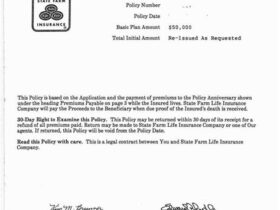Understanding the different types of life insurance companies is crucial when making decisions about your financial future. While many life insurance companies are structured as stock companies, another important model is the mutual life insurance company. This article delves into what a mutual life insurance company is, how it operates, its pros and cons, and how it differs from a stock life insurance company. This guide will provide you with the knowledge necessary to assess whether a mutual life insurance company aligns with your financial goals.
Defining a Mutual Life Insurance Company
A mutual life insurance company is a unique type of financial institution. Unlike stock life insurance companies that are owned by shareholders, a mutual life insurance company is owned by its policyholders. This fundamental difference in ownership structure shapes how the company operates and distributes profits. In essence, when you purchase a policy from a mutual company, you become a part-owner of the company. This means you potentially have a say in how the company is run and how its profits are distributed.
How Mutual Life Insurance Companies Operate
The operational model of a mutual life insurance company centers around its policyholders. Here’s a breakdown of key aspects:
- Ownership and Governance: Policyholders are the owners and have the right to vote in the election of the company’s board of directors. This board is responsible for setting the company’s strategic direction and overseeing its management.
- Profit Distribution: Mutual companies aim to operate for the benefit of their policyholders. If the company performs well and generates a surplus, these profits are often distributed to policyholders in the form of dividends.
- Focus on Long-Term Stability: Because mutual companies don’t have the same pressures from shareholders as stock companies, they often prioritize long-term financial stability and the interests of their policyholders over short-term gains. This can translate to a more conservative investment approach.
- Surplus and Reserves: Mutual companies maintain surpluses and reserves to ensure they can meet their obligations to policyholders, even in challenging economic times. These reserves act as a financial cushion, providing security and stability.
Advantages of Choosing a Mutual Life Insurance Company

Choosing a mutual life insurance company offers several potential benefits:
- Potential Dividends: As owners, policyholders may receive dividends, which can reduce the overall cost of insurance or be reinvested to increase the policy’s value.
- Alignment of Interests: The company’s focus is on serving its policyholders, aligning its interests with yours. This can lead to better customer service and a more personalized approach.
- Long-Term Stability: The emphasis on long-term stability can provide peace of mind, knowing that the company is focused on meeting its obligations well into the future.
- Policyholder Voice: Policyholders have a voice in the company’s governance through voting rights.
Disadvantages of Choosing a Mutual Life Insurance Company
While mutual life insurance companies offer many advantages, there are also some potential drawbacks to consider:
- Slower Growth: The focus on long-term stability and a more conservative investment approach can sometimes result in slower growth compared to stock companies.
- Dividends Not Guaranteed: Dividends are not guaranteed and can fluctuate based on the company’s financial performance.
- Less Access to Capital: Mutual companies may have limited access to capital compared to stock companies, which can raise funds through the stock market.
- Complexity: Understanding the ownership structure and governance of a mutual company can be more complex than with a stock company.
Mutual vs. Stock Life Insurance Companies: Key Differences
The fundamental difference between mutual and stock life insurance companies lies in their ownership structure:
| Feature | Mutual Life Insurance Company | Stock Life Insurance Company |
|---|---|---|
| Ownership | Policyholders | Shareholders |
| Profit Focus | Policyholder Benefits | Shareholder Profits |
| Dividend Payments | To Policyholders (Not Guaranteed) | To Shareholders (Potentially Higher) |
| Governance | Policyholders Elect Board of Directors | Shareholders Elect Board of Directors |
| Capital Raising | Primarily Through Retained Earnings | Through Stock Offerings |
| Risk Tolerance | Generally More Conservative | Potentially More Aggressive |
Examples of Mutual Life Insurance Companies
Several well-established life insurance companies operate on a mutual structure. Some notable examples include:
- New York Life Insurance Company: One of the oldest and largest mutual life insurance companies in the United States.
- Northwestern Mutual: Another prominent player in the mutual life insurance sector.
- Massachusetts Mutual Life Insurance (MassMutual): A well-regarded mutual company offering a range of financial products.
These companies have a long history of serving policyholders and prioritize financial stability.
How to Evaluate a Mutual Life Insurance Company
Before choosing a mutual life insurance company, consider the following factors:
- Financial Strength: Assess the company’s financial ratings from independent agencies like A.M. Best, Standard & Poor’s, and Moody’s.
- Dividend History: Review the company’s dividend history to understand its track record of distributing profits to policyholders. However, remember that past performance is not indicative of future results.
- Policy Options: Ensure the company offers a range of policy options that meet your specific needs.
- Customer Service: Research the company’s customer service reputation and read reviews from other policyholders.
- Company Values: Consider whether the company’s values align with your own. Do they prioritize long-term stability and policyholder benefits?
Conclusion

Mutual life insurance companies offer a unique ownership structure that prioritizes the needs of their policyholders. While they may not be the right choice for everyone, they can be an attractive option for those seeking long-term stability, potential dividends, and a company that aligns its interests with their own. By understanding the advantages and disadvantages of mutual companies, and by carefully evaluating your options, you can make an informed decision that supports your financial future. Always consult with a qualified financial advisor to determine the best insurance strategy for your individual circumstances.







Leave a Reply